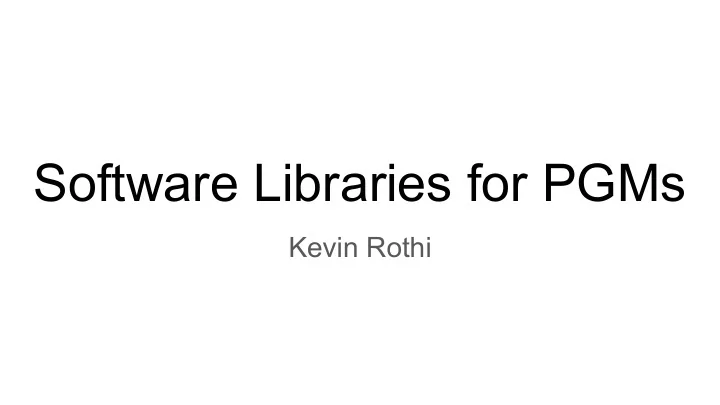

Software Libraries for PGMs Kevin Rothi
Very popular tools for ML/NNs/Deep Learning... - SciKit Learn - Tensorflow - Keras - Torch - CUDA - Theano - Caffe
No shortage of small libraries for graphical models… http://www.cs.ubc.ca/~murphyk/Software/bnsoft.html (Last updated 16 June 2014) 69 Libraries
Of these... 23 use junction trees for inference (some use Jtrees in addition to other algos) 5 use gibbs sampling Many seem to be defunct, unsupported, or abandoned… Why are there so many of these?
“It’s hard to strike a balance between generality and usability.” -Prof. Ihler
Positive qualities of software libraries… (CISQ) Reliable Efficient Secure Maintainable Appropriately Scoped (Size) “CISQ has defined five major desirable characteristics of a piece of software needed to provide business value…” (https://en.wikipedia.org/wiki/Software_quality)
The rest of this talk will focus on the libraries that can begin to convincingly claim to fulfill these qualities (in my opinion)
...
Generality Usability
“Python library for Probabilistic Graphical Models” - Details are sparse, but it seems that this library has its origins as a Google Summer of Code project. There appear to be 4 major contributors: Ankur Ankan from Radboud University, Yashu Seth, Abinash Panda, Utkarsh Khalibartan, and an unnamed GitHub user contributing under the handle “vivek425ster”. - Open source - Version 0.1.2 - Still under development (last commit on April 11) - MIT License - 48 contributors
Models Bayesian Model Markov Model Factor Graph Cluster Graph Junction Tree Markov Chain NoisyOr Model Naive Bayes DynamicBayesianNetwork
Sampling Methods Gibbs Sampler Bayesian Model Samplers Hamiltonian Monte Carlo No U-Turn Sampler
Algorithms Variable Elimination Belief Propagation MPLP Dynamic Bayesian Network Inference
Positives Very approachable (well documented) Actively supported (bug fixes, features added) Python
Negatives Not backed by Big 4 company Development seems to be slowing down (fewer commits over time)
2nd half of talk will focus on examples of what you can do with pgmpy...
Generality Usability
“A C++ Library for Discrete Graphical Models” - Developed at The Heidelberg Collaboratory for Image Processing at the University of Heidelberg. There are 3 main developers: Bjoern Andres, Thorsten Beier, and Joerg H. Kappes. - Open source - Version 2.0.2 - Still under development (last commit on April 5) - MIT License - 38 contributors - Wrappers for Python and Matlab
Models Graphs of any order and structure, from second order grid graphs to irregular higher-order models
Algorithms - Combinatorial/Global Optimal Methods - Linear Programming Relaxations - Message Passing Methods - Move Making Methods - Sampling - Wrapped External Code for Discrete Graphical Models (41 total by my count)
Positives Highly general C++ Extensive Documentation
Negatives Not backed by a Big 4 company Highly general C++
Generality Usability
“Edward is a Python library for probabilistic modeling, inference, and criticism. It is a testbed for fast experimentation and research with probabilistic models, ranging from classical hierarchical models on small data sets to complex deep probabilistic models on large data sets. Edward fuses three fields: Bayesian statistics and machine learning, deep learning, and probabilistic programming.” “Formally, Edward is a Turing-complete probabilistic programming language.” - Developed at Columbia University. Primary Developer: Dustin Tran - Open source - Version 1.3.5 - Still under development (last commit on June 1) - MIT License - 77 contributors
An abstraction over tensorflow Directed graphical models Neural networks (via libraries such as tf.layers and Keras) Implicit generative models Bayesian nonparametrics and probabilistic programs
Inference with... Variational inference Black box variational inference Stochastic variational inference Generative adversarial networks Maximum a posteriori estimation Monte Carlo Gibbs sampling Hamiltonian Monte Carlo Stochastic gradient Langevin dynamics Compositions of inference Expectation-Maximization Pseudo-marginal and ABC methods Message passing algorithms
Generality Usability
“SamIam is a comprehensive tool for modeling and reasoning with Bayesian networks” - Developed at University of California, Los Angeles by the Automated Reasoning Group of Professor Adnan Darwiche. - Closed source
Kevin’s notes on SamIam I took a look at this tool. It’s impressive in the sense that the UI is very well designed and the fact that it’s a Java program means that it can run on any machine with a Java virtual machine implementation, but the project is not open source. I can call into the code, but I can neither see nor edit the code. In my opinion, this is a serious issue. Why not host the code on Github? Also, it’s not clear what the licensing is for this software. Can I use it in an industrial/commercial application? All of these factors limit SamIam’s utility, unfortunately.
Installation... pip install if you’re on linux Easy, fast, basically error-proof
(As an aside…) There’s an R package called bnlearn (http://www.bnlearn.com/) If you go to http://www.bnlearn.com/bnrepository/ there are Bayesian networks (large and small) to test with!
(As another aside…) daft-pgm.org
Back to pgmpy...
Generality Usability
I hope this was helpful, interesting, or provided some ideas about potential future work. Thank you! Questions?
Recommend
More recommend